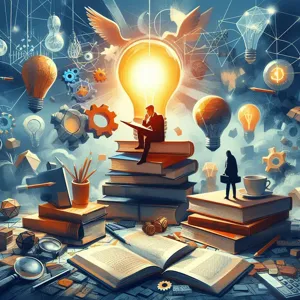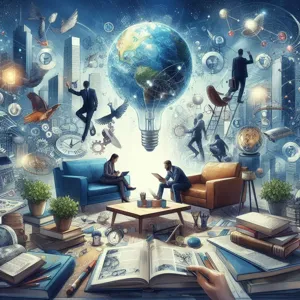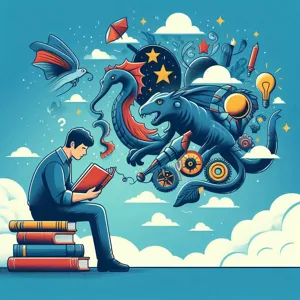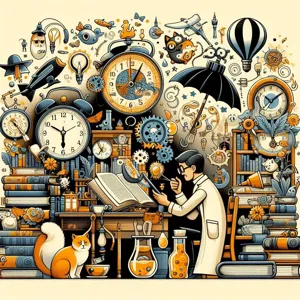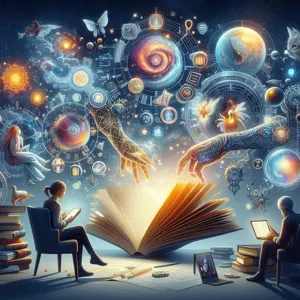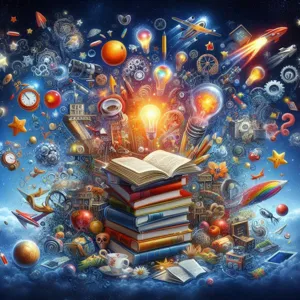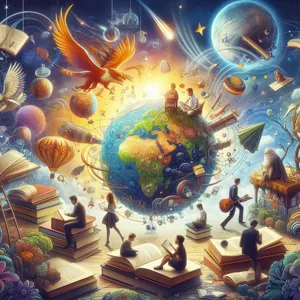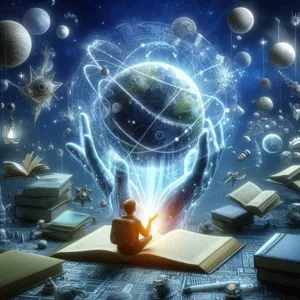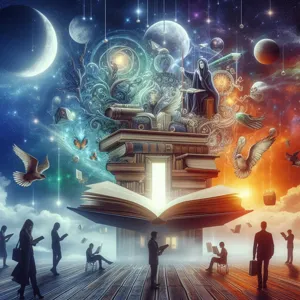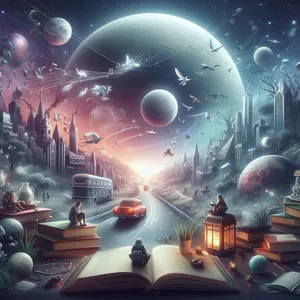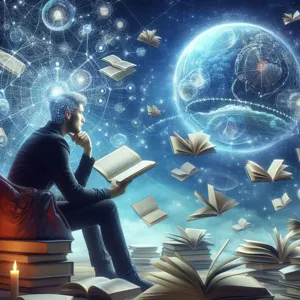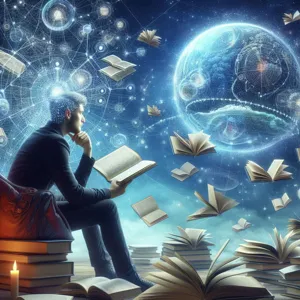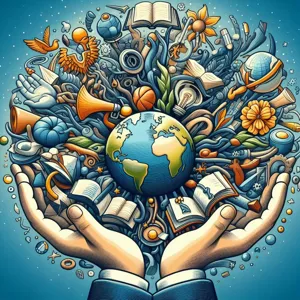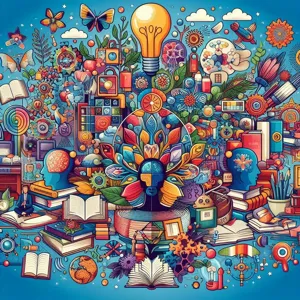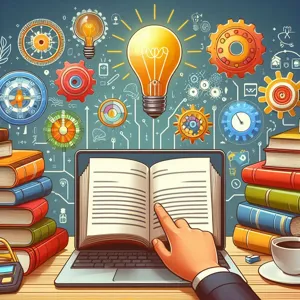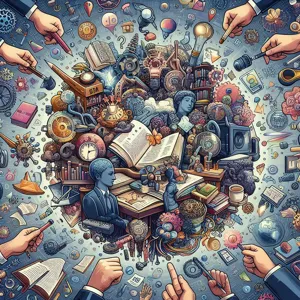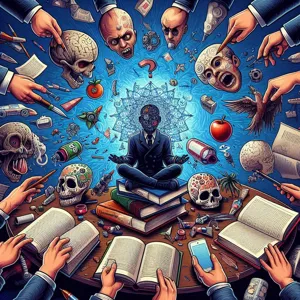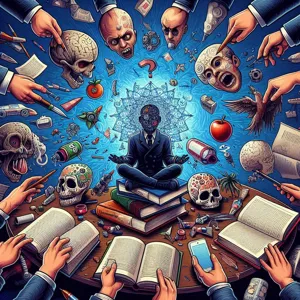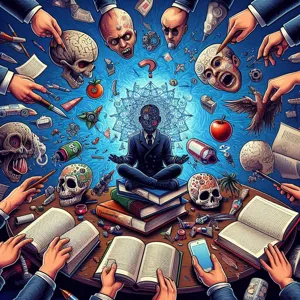In a world brimming with endless information and diverse narratives, the written word remains a powerful form of expression.
Yet, many aspiring writers grapple with finding their unique voice amidst the cacophony of styles and genres. What if the key to unlocking your authentic writing potential lies in the pages of a book? In this blog post, we’ll explore how reading not only enriches your vocabulary and sharpens your grammar but also profoundly transforms your writing skills. By immersing yourself in the works of accomplished authors, you’ll discover the nuances of tone, rhythm, and style that can elevate your own prose. Join us as we delve into the transformative relationship between reading and writing, revealing how the stories you absorb can ignite your creativity and empower you to craft compelling narratives that resonate with your readers.
1. The Connection Between Reading and Writing

Reading and writing are two sides of the same coin, each profoundly influencing and enhancing the other. When you dive into a good book, you’re not just absorbing storylines and characters; you’re also subconsciously studying the nuances of language, structure, and style. Every author has a unique voice, and by immersing yourself in diverse genres and formats, you begin to recognize the patterns that resonate and those that fall flat.
consider how a poet’s carefully chosen words can evoke deep emotions or how a novelist’s intricate plots can keep you turning pages late into the night. Each piece you read provides a model for what effective writing looks like, offering lessons in vocabulary, rhythm, punctuation, and the art of storytelling itself. As you encounter different authors’ techniques—from Hemingway’s succinct sentences to Woolf’s stream-of-consciousness style—you gather a toolkit of strategies to experiment with in your own writing.
Moreover, reading widely expands your knowledge base, enriching your writing with fresh ideas and perspectives. When you expose yourself to various themes and concepts, you begin to see connections that inspire your creativity. This cross-pollination of ideas can spark new thoughts, helping you overcome writer’s block and infuse your work with originality.
Ultimately, the connection between reading and writing is an ongoing dialogue. The more you read, the more you refine your voice, enhancing your ability to express your thoughts and emotions on the page. Embrace this relationship, and you’ll find that each book you finish adds layers to your writing, transforming it into a richer and more engaging experience for both you and your readers.
2. Understanding Different Writing Styles Through Reading
Understanding different writing styles through reading is akin to immersing yourself in a vibrant tapestry of language, rhythm, and expression. Every author possesses a unique voice, a signature style that colors their narratives and influences their storytelling. By diving into a diverse range of literature—from contemporary novels and classic poetry to journalistic articles and persuasive essays—you expose yourself to a myriad of techniques and approaches that can enrich your own writing arsenal.
For instance, reading the concise, impactful prose of Hemingway can teach you the power of simplicity and clarity, while delving into the intricate, flowing sentences of Virginia Woolf may inspire you to explore stream-of-consciousness writing. Each genre, whether it’s a gripping thriller or an insightful memoir, showcases different stylistic choices, such as tone, pacing, and structure.
As you engage with these various forms, take note of what resonates with you. How does a particular author evoke emotion through their word choice? What techniques do they use to build suspense or develop character? By analyzing these elements, you not only deepen your appreciation for the craft but also discover the tools you can wield in your own writing.
Moreover, understanding different writing styles helps you find your voice. You might mimic the structure of a beloved author while infusing it with your own experiences and perspectives. This exploration fosters creativity, allowing you to experiment with different styles until you uncover the one that feels most authentic to you.
In essence, reading is not merely a passive activity; it’s an active dialogue with the text that informs and inspires. By embracing the diverse tapestry of writing styles, you unlock the potential to transform your own voice, ultimately enhancing your writing skills in ways you never thought possible.
3. How Reading Expands Your Vocabulary
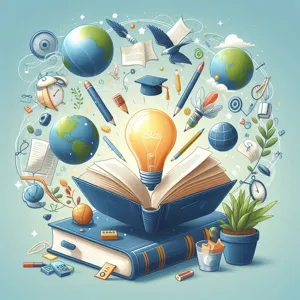
Reading is one of the most effective ways to expand your vocabulary, and this expansion is a vital component of enhancing your writing skills. Each time you open a book, magazine, or article, you immerse yourself in a world of language that is rich and varied. You’ll encounter words that may be unfamiliar to you, and this exposure allows you to see how different words fit together in context, helping you to understand their meanings and nuances.
When you read diverse genres—be it fiction, poetry, non-fiction, or even technical writing—you’ll discover a spectrum of vocabulary that stretches beyond everyday language. A literary novel might introduce you to lyrical expressions and complex sentence structures, while a well-researched article could familiarize you with industry-specific jargon and terminology. This blend not only broadens your lexical repertoire but also sharpens your ability to choose the perfect word for each occasion in your own writing.
Moreover, as you encounter new words, consider keeping a vocabulary journal. This simple practice allows you to jot down interesting words, their meanings, and example sentences. Over time, you’ll build a personalized lexicon that you can draw upon in your own writing. The next time you sit down to craft a story, essay, or blog post, you’ll find that the words you’ve collected become a treasure trove of inspiration, enhancing your ability to express your thoughts with clarity and creativity.
In essence, reading is a gateway to a richer vocabulary, and as your vocabulary expands, so too does your capacity to articulate ideas and emotions on the page. By absorbing the language of others, you pave the way for your unique voice to emerge, transforming your writing into a more powerful and engaging form of communication.
4. Analyzing Structure: What Great Writers Do
Analyzing the structure of great writing is a powerful exercise that can elevate your own writing skills significantly. When you read the works of accomplished authors, pay attention to how they organize their thoughts, develop their narratives, and craft their arguments. This deeper understanding of structure can unveil a treasure trove of techniques that you can adapt to your writing style.
Great writers often employ a clear and purposeful structure that guides the reader smoothly through their work. Look for how they introduce their ideas and set the tone in the opening paragraphs. Notice the way they build momentum, using transitions that connect one idea to the next, creating a natural flow that keeps the reader engaged. This careful arrangement enhances the clarity of their message, making complex ideas more digestible.
Moreover, consider how they conclude their pieces. A strong conclusion does more than simply summarize; it resonates with the reader, leaving them with a lasting impression. Analyzing these elements helps you recognize patterns that work, allowing you to experiment with different structures in your writing.
By dissecting the work of great writers, you’ll also discover how they balance narrative with exposition, dialogue with description. This balance is crucial in keeping your audience captivated while ensuring that your message comes across effectively.
Ultimately, learning to analyze the structure of great writing empowers you to make conscious choices in your own work. It encourages you to think critically about how best to convey your ideas, helping you unlock your unique voice while mastering the art of writing. So, the next time you pick up a book, take a moment to not just enjoy the story, but to dissect the architecture behind the words—your writing will thank you for it.
5. The Role of Genre in Shaping Your Voice

The genre you choose to explore can significantly influence and shape your writing voice, as each genre comes with its unique conventions, styles, and expectations. Whether you’re delving into fiction, non-fiction, poetry, or even journalism, understanding the nuances of these genres allows you to adapt your tone, vocabulary, and pacing to better resonate with your audience.
For instance, reading contemporary fiction can help you develop a more narrative-driven, immersive voice, filled with rich characterizations and emotional depth. Conversely, diving into the world of poetry might encourage you to embrace brevity and experiment with rhythm, imagery, and metaphor, honing your ability to convey profound ideas in just a few words. Similarly, engaging with non-fiction can enhance your ability to present facts and arguments clearly and persuasively, teaching you to adopt a more authoritative tone that builds credibility with your readers.
As you navigate through different genres, pay attention to how various authors wield their voices. Notice how a mystery writer builds suspense with short, clipped sentences, while a romantic novelist might employ lush, descriptive language to evoke emotion. By analyzing these stylistic choices, you can begin to incorporate elements that resonate with you into your own writing, gradually crafting a voice that is distinctly your own.
Ultimately, immersing yourself in a variety of genres not only broadens your understanding of language and style but also encourages you to experiment and play with your own voice. As you unlock new ways of expressing yourself through writing, you’ll find that your voice becomes more dynamic, adaptable, and authentic, allowing you to connect more deeply with your readers, regardless of the genre you choose to embrace.
6. Learning from Literary Techniques and Devices
When you immerse yourself in the world of literature, you are not just reading words on a page; you are absorbing a treasure trove of literary techniques and devices that can significantly elevate your own writing. Each novel, poem, or essay offers a unique lens through which to view language, structure, and storytelling. By analyzing how authors craft their narratives, use metaphors, play with rhythm, and build tension, you can glean invaluable insights that will enhance your own writing style.
For instance, consider the use of imagery. Great writers paint vivid pictures with their words, making their settings and characters come alive in the reader’s mind. By paying attention to how these authors employ sensory details, you can learn to create more engaging and immersive scenes in your work. Similarly, exploring the use of foreshadowing can teach you how to build suspense and keep your readers on the edge of their seats, eagerly turning the pages to see what happens next.
Additionally, studying dialogue can refine your ability to create authentic conversations that resonate with readers. Notice how different authors capture distinct voices and personalities through their characters’ speech patterns and word choices. This practice will not only improve your dialogue but will also help you develop well-rounded, relatable characters.
Furthermore, delving into various genres exposes you to a multitude of styles and approaches to storytelling. Whether it’s the lyrical prose of literary fiction or the punchy, fast-paced narrative of thrillers, each genre comes with its own set of conventions that can inspire and inform your writing.
In essence, as you learn from the literary techniques and devices employed by others, you’ll discover new ways to express your thoughts and emotions. Reading becomes a powerful tool in your writing arsenal, unlocking your voice and sharpening your skills with every page turned. So, the next time you pick up a book, pay attention not just to the story but to the craft behind it—your writing will thank you for it.
7. The Impact of Diverse Perspectives on Your Writing

When it comes to writing, diversity is not just a buzzword; it’s a powerful catalyst for creativity and growth. Engaging with a wide range of perspectives can profoundly influence your writing style, voice, and overall narrative. Reading works from authors of different backgrounds, cultures, and experiences exposes you to unique storytelling techniques, varied language use, and distinct thematic explorations. Each author brings their own lens to the page, allowing you to see the world through myriad viewpoints.
For instance, when you delve into the rich narratives of an African writer versus a contemporary American author, you may encounter contrasting approaches to character development, plot structure, and dialogue. This exposure broadens your understanding of how different life experiences shape storytelling. It encourages you to break free from conventional molds and experiment with your own voice, infusing your writing with authenticity and depth.
Moreover, diverse perspectives challenge your preconceived notions and biases, fostering empathy and understanding. As you read about characters from backgrounds vastly different from your own, you gain insight into their struggles, triumphs, and everyday realities. This depth of understanding can enrich your writing, allowing you to create multi-dimensional characters and relatable story arcs that resonate with a broader audience.
Incorporating these varied influences into your writing practice can also spark innovative ideas and fresh concepts. It encourages you to think outside the box and approach topics from angles you may not have considered before. So, as you unlock your voice through reading, remember to embrace the richness that diverse perspectives offer. They can be the key to elevating your writing and making it not only more engaging but also more impactful.
8. How Reading Aloud Enhances Rhythm and Flow
Reading aloud is one of the most powerful yet often overlooked techniques for honing your writing skills. When you vocalize your words, you engage a different part of your brain, allowing you to experience your writing in a fresh and dynamic way. As you read, you begin to notice the rhythm and flow of your sentences—the rise and fall of phrases, the pauses that create suspense, and the cadences that convey emotion.
This auditory experience helps you identify awkward phrasing or clunky transitions that might go unnoticed when reading silently. For instance, if a sentence feels too long or convoluted when spoken, it’s a clear signal that it may need restructuring. Similarly, as you read, you may discover powerful moments where your writing soars, and these insights can guide you in crafting similar beats throughout your work.
Moreover, reading aloud can enhance your understanding of pacing. Just as a musician feels the tempo of a piece, a writer can grasp the tempo of their narrative through spoken word. This practice encourages you to vary sentence length and structure, creating a more engaging rhythm that captivates your readers. It can even help you develop a unique voice, as you become more attuned to the sounds and sensations of your language.
Finally, reading aloud fosters confidence in your writing. Hearing your own words brings them to life, making you more likely to embrace your style and perspective. This newfound assurance can translate into bolder choices in your writing, allowing you to take risks and experiment with your voice. So, the next time you sit down to refine your piece, don’t just keep your thoughts to yourself—let them resonate in the air around you, and watch as your writing transforms into a symphony of rhythm and flow.
9. Developing Critical Thinking Skills Through Reading
Reading is not merely an exercise in absorbing sentences; it is a profound catalyst for developing critical thinking skills. When you immerse yourself in a book, whether it’s a thought-provoking essay, an intricate novel, or a compelling biography, you engage with diverse perspectives and complex ideas. This engagement compels you to analyze, question, and reflect on what you read.
As you navigate the twists and turns of a narrative or dissect the arguments presented in an article, you begin to develop the ability to assess information critically. You learn to identify biases, recognize logical fallacies, and distinguish between fact and opinion. For instance, when exploring differing viewpoints in a political treatise, you are prompted to evaluate the strengths and weaknesses of each argument, ultimately shaping your own opinion in the process.
Moreover, reading challenges you to think beyond the surface. When you encounter characters with conflicting motivations or themes that resonate with your own experiences, you are invited to explore deeper meanings and implications. This kind of analytical thinking is invaluable in writing; it equips you with the tools to construct well-rounded arguments, create multidimensional characters, and weave intricate plots.
Engaging with a variety of genres and styles also broadens your cognitive horizons. Each author presents unique structures, tones, and techniques that inspire you to innovate in your own writing. By critically examining these elements, you cultivate a more nuanced understanding of narrative construction and rhetorical strategies.
In essence, reading sharpens your mental faculties, enabling you to approach your writing with clarity and precision. The more you read, the more adept you become at articulating your thoughts, crafting compelling narratives, and engaging your audience—transforming the way you express yourself on the page. So, the next time you pick up a book, remember: you’re not just reading; you’re honing your critical thinking skills and unlocking the potential to elevate your writing.
10. The Importance of Consistent Reading Habits
Consistent reading habits are the backbone of developing a strong writing voice. Just as athletes train regularly to hone their skills, writers must immerse themselves in the written word to cultivate their craft. When you read daily, whether it’s novels, essays, or poetry, you expose yourself to various styles, tones, and techniques that can enrich your own writing. Each book you dive into serves as a mentorship of sorts, offering insights into sentence structure, vocabulary, and narrative pacing.
Moreover, reading consistently helps you understand different perspectives and cultures, broadening your worldview and equipping you with a diverse range of ideas to draw from. This exposure not only enhances your creativity but also deepens your empathy, allowing you to create characters and narratives that resonate with readers on a personal level.
Imagine curling up with a captivating novel—every turn of the page reveals new storytelling methods, dialogue styles, and emotional depths. By analyzing how authors construct their stories, you can adapt and experiment with these techniques in your own writing. Over time, this practice leads to a more refined style that is distinctly yours, enriched by the myriad voices you’ve encountered along the way.
To foster these habits, set aside dedicated time for reading each day, even if it’s just for a few minutes. Create a reading list that challenges you with a mix of genres and authors. As you make reading a priority, you’ll find that your writing becomes more fluid, expressive, and impactful. In essence, the more you read, the more you unlock your voice, allowing your unique narrative to shine through.
11. Creating a Reading List to Enhance Your Writing
Creating a reading list to enhance your writing is one of the most effective strategies you can employ to unlock your voice and refine your craft. A thoughtfully curated reading list serves as a treasure trove of inspiration and instruction, exposing you to diverse styles, genres, and perspectives. It acts as a roadmap, guiding you through the literary landscape while allowing you to explore the nuances of language and storytelling.
Start by selecting a mix of classic literature, contemporary works, and genre-specific texts that resonate with your interests. Consider including novels, short stories, poetry, and even essays—each form offers unique insights into structure, character development, and thematic exploration. For instance, reading a well-crafted novel can teach you the intricacies of plot pacing and character arcs, while diving into poetry can sharpen your ability to convey emotion through succinct language.
Don’t shy away from reading outside your comfort zone. Engaging with different voices and styles can challenge your perceptions and broaden your horizons, helping you to embrace new techniques and ideas. If you’re drawn to fiction, consider adding non-fiction books about writing, such as style guides or memoirs from renowned authors. These can provide invaluable advice and firsthand accounts of the writing process, enriching your understanding of the craft.
As you build your list, make it a point to include books that evoke strong emotional responses or provoke thought. Reflect on why certain passages resonate with you—what makes the language sing, or how does the author create tension? Take notes as you read, jotting down phrases that inspire you, stylistic choices that intrigue you, or even questions that arise. This active engagement not only deepens your appreciation for the literature but also translates into your own writing.
Lastly, remember that a reading list should evolve. Allow your interests and writing goals to guide your selections, and periodically reassess your list to include new discoveries. By immersing yourself in the written word, you will unlock new dimensions of creativity and develop a voice that is uniquely your own. Reading becomes not just a pastime but a vital part of your writing journey, one that continually shapes and refines your skills.
12. The Feedback Loop: How Reading Influences Your Writing Process
The relationship between reading and writing is often described as a feedback loop—a dynamic interplay where each activity enhances the other. When you immerse yourself in the written word, whether it’s a novel, an article, or a poem, you’re not just absorbing information; you’re also experiencing different styles, tones, and techniques that can inform your own writing. This continuous cycle of influence is essential for any aspiring writer looking to refine their craft.
As you read, pay close attention to the choices authors make. Notice how they structure their sentences, develop their characters, or build tension within their narratives. Each book you devour becomes a lesson in storytelling, helping you to identify what resonates with you and what doesn’t. This critical analysis allows you to incorporate elements into your own writing, shaping your unique voice while simultaneously expanding your toolkit of literary techniques.
But the feedback loop doesn’t stop with reading. After you write, returning to your favorite books can provide perspective on your work. You can ask yourself, “How would my favorite author approach this scene?” or “What techniques are they using that I can learn from?” This reflective practice not only strengthens your writing but also fosters a deeper appreciation for the craft.
Engaging with others through writing groups or workshops can further enhance this feedback loop. Sharing your work provides opportunities for constructive critiques, allowing you to see your writing through fresh eyes. Just as reading offers inspiration and technique, receiving feedback from peers can illuminate areas for growth, sparking new ideas and directions in your writing journey.
Ultimately, the feedback loop between reading and writing is a powerful catalyst for growth. By actively engaging with a wide range of texts and seeking feedback on your work, you create a rich ecosystem that nurtures your creativity and hones your writing skills, unlocking your true voice along the way.
13. Engaging with Author Interviews and Writing Workshops
Engaging with author interviews and writing workshops is an invaluable way to further refine your voice and enhance your writing skills. Author interviews provide a unique glimpse into the minds of seasoned writers, allowing you to explore their creative processes, challenges, and triumphs. Listening to them discuss their experiences can ignite fresh ideas and inspire you to experiment with your own writing style.
Many authors share their insights on topics such as character development, world-building, and the nuances of dialogue. By absorbing their perspectives, you can glean practical techniques that resonate with your personal writing journey. Whether it’s a casual podcast conversation or a formal video interview, these resources can serve as a treasure trove of knowledge, expanding your understanding of the art of storytelling.
On the other hand, participating in writing workshops offers a hands-on opportunity to practice your craft in a supportive environment. These workshops foster a sense of community, where writers come together to share their work, receive constructive feedback, and engage in collaborative exercises. The immediate input from peers and mentors can be transformative, helping you identify strengths and areas for improvement in your writing.
Moreover, the structured atmosphere of a workshop encourages you to step outside your comfort zone, experiment with new techniques, and explore genres you might not have considered before. The camaraderie and accountability found in these settings can reignite your passion for writing and push you to elevate your skills to new heights.
In essence, engaging with author interviews and writing workshops not only expands your knowledge but also nurtures your creativity, fueling your development as a writer. By immersing yourself in the experiences of others and actively participating in collaborative environments, you unlock new avenues for expression and growth, ultimately leading to a more authentic and powerful voice in your writing.
14. Practical Exercises to Combine Reading and Writing
To truly harness the transformative power of reading on your writing, incorporating practical exercises into your routine can make a world of difference. These exercises not only bridge the gap between the two skills but also encourage a deeper understanding of language, style, and narrative structure.
**1. Annotate as You Read:** One of the most effective ways to combine reading and writing is through annotation. As you read, underline striking phrases, jot down your thoughts in the margins, or highlight sections that resonate with you. This practice encourages active engagement with the text and provides a repository of inspiration for your own writing. Later, revisit these notes and explore how you can incorporate similar techniques or styles into your work.
**2. Imitation Exercises:** Choose a passage from a favorite author and try to mimic their style. This doesn’t mean copying their work, but rather experimenting with their sentence structure, tone, and rhythm. Write a short piece in the same style, whether it’s a descriptive paragraph, a dialogue exchange, or narrative storytelling. This exercise will help you identify the nuances of different voices and how they can influence your own.
**3. Reading Aloud:** Reading your favorite pieces aloud can be an enlightening experience. It allows you to hear the flow and cadence of the writing, helping you become more aware of sentence structure and word choice. Afterward, try writing a paragraph or two that mirrors the auditory qualities of what you’ve just read. Pay attention to how the rhythm and sound of words can enhance your writing.
**4. Create a Reading Journal:** Dedicate a notebook to reflections on your reading. After finishing a book or article, write a brief summary of your thoughts, what you learned, and how it could influence your writing. Set specific goals for what you want to emulate in your own work—be it character development, plot pacing, or descriptive language.
**5. Write Responses to What You Read:** Engage critically with texts by writing responses or reviews. This not only solidifies your understanding of the material but also hones your analytical writing skills. Whether you agree or disagree with the author, articulating your thoughts on their arguments or narrative choices can lead to profound insights that will enrich your own writing.
By integrating these practical exercises into your routine, you’ll find that the boundaries between reading and writing begin to dissolve. Each book you pick up can become a wellspring of inspiration, guiding you to unlock your unique voice while simultaneously sharpening your skills as a writer. Embrace this dynamic relationship, and watch as your writing flourishes in ways you never imagined.
15. Conclusion: Embracing Reading as a Tool for Writing Mastery
In the journey of becoming a skilled writer, embracing reading as a fundamental tool can significantly transform your craft. As we conclude our exploration of how reading influences writing, it’s essential to reflect on the profound connection between these two activities. Reading expands your vocabulary, exposes you to diverse styles, and introduces you to different voices—each of which enriches your own writing repertoire.
When you immerse yourself in the pages of a novel, an essay, or even a poem, you are not merely consuming information; you are engaging in a dialogue with the author. This interaction sharpens your ability to discern tone, rhythm, and narrative structure. You begin to understand what makes a sentence resonate or a character come alive, and you can incorporate these techniques into your own work.
Moreover, reading regularly fosters a habit of observation. You start to notice the nuances in language and the intricacies of storytelling. This awareness can spark your creativity and inspire you to experiment with your own voice. Just as musicians learn by listening to others, writers grow by reading widely and critically.
In this digital age, where distractions abound, carving out dedicated time for reading can feel like a challenge. However, prioritizing this practice is crucial for your development as a writer. Whether it’s a few pages before bed or a chapter during your lunch break, every moment spent with a book contributes to your growth.
So, as you embark on your writing journey, remember to embrace reading not just as a pastime, but as an essential tool for mastery. Allow the words of others to ignite your own creativity, and watch as your writing flourishes in ways you never thought possible. By intertwining these two passions, you unlock the full potential of your voice, transforming your writing into a powerful means of expression.
In conclusion, unlocking your voice through reading is not just a path to enhancing your writing skills; it’s an enriching journey that deepens your understanding of language, style, and expression. As you immerse yourself in diverse genres and authors, you’ll discover new perspectives and techniques that can elevate your own writing. Remember, every page you turn adds to your toolkit, empowering you to articulate your thoughts with clarity and creativity. Embrace the transformative power of reading, and watch as your unique voice emerges, resonating through every piece you craft. So, grab that next book, and let the magic of storytelling inspire your writing journey!


